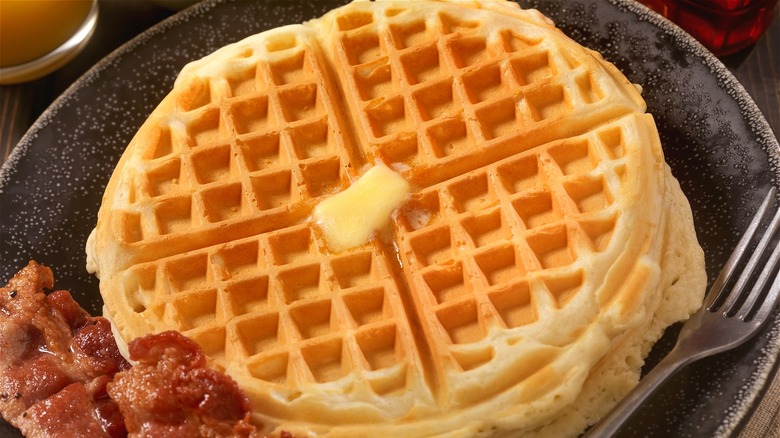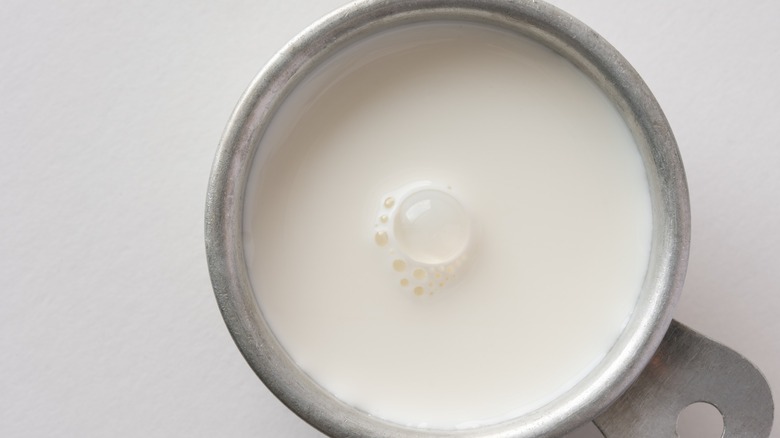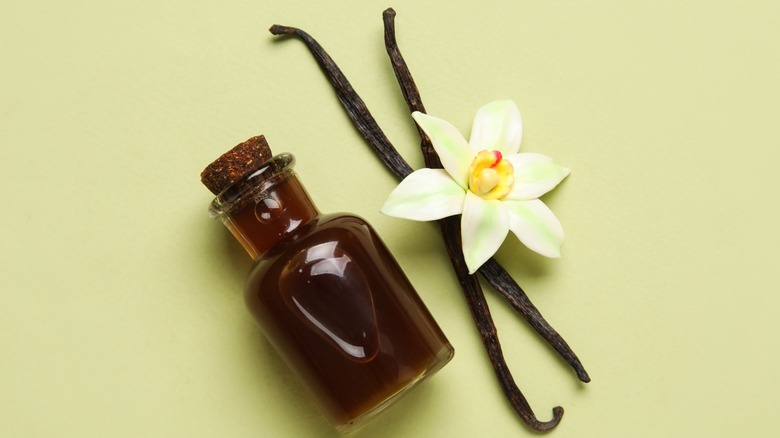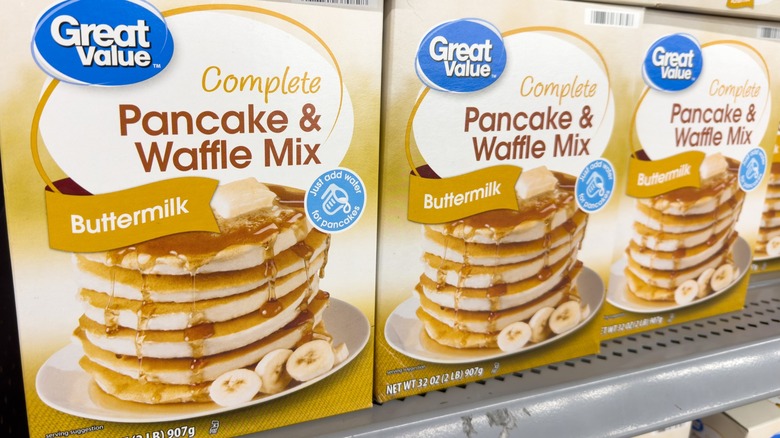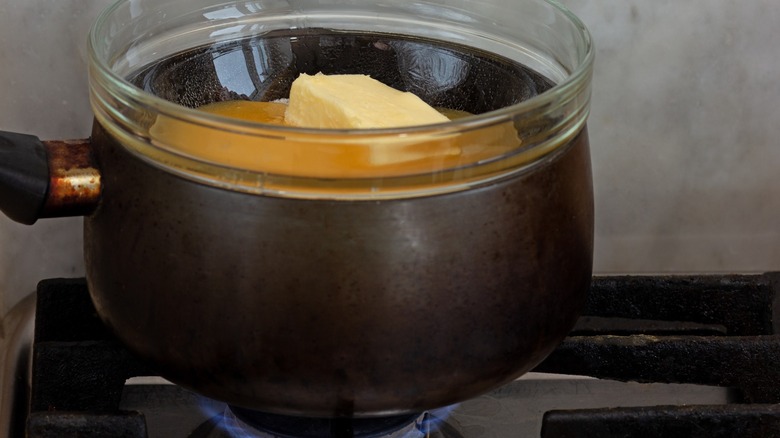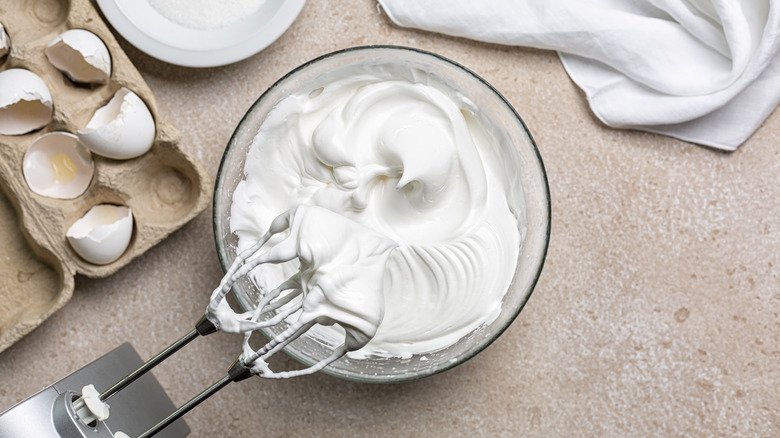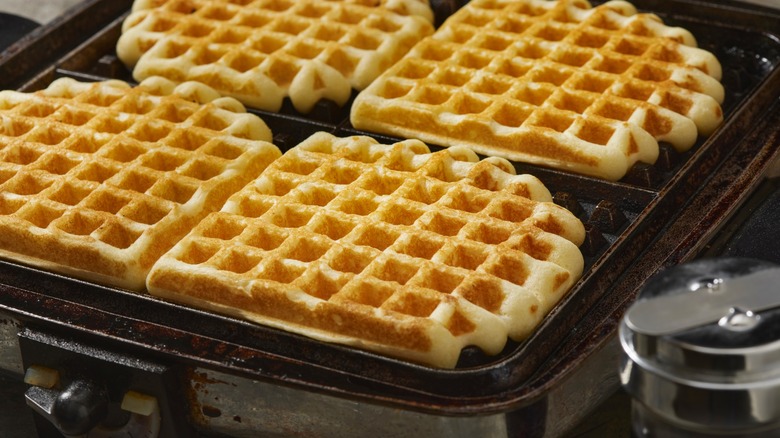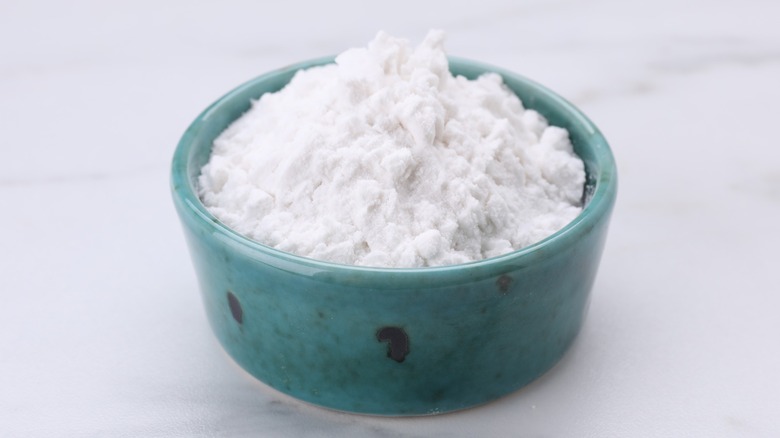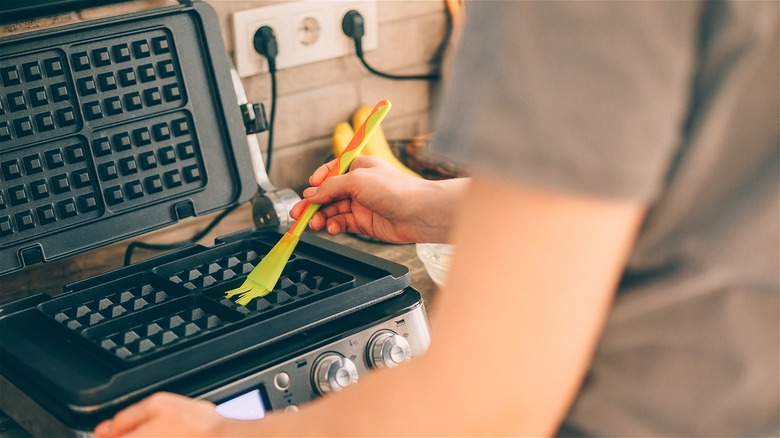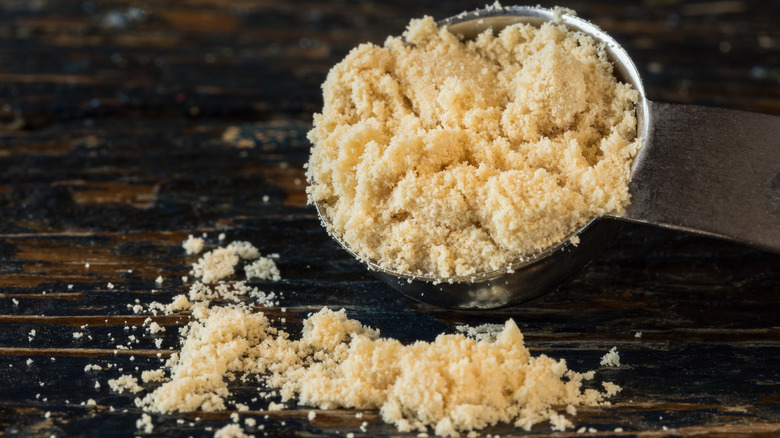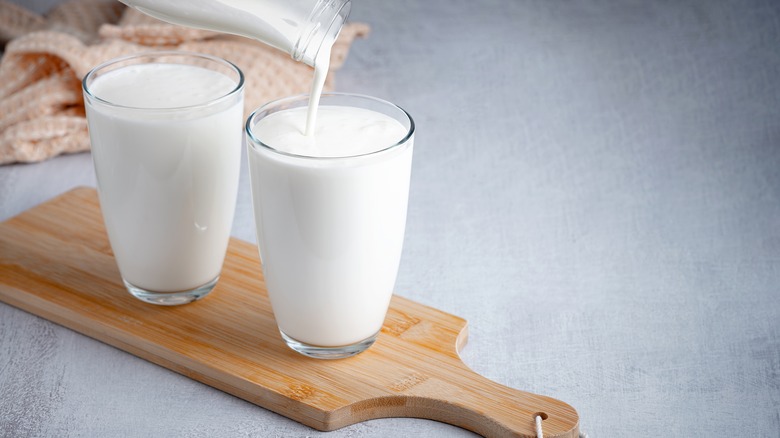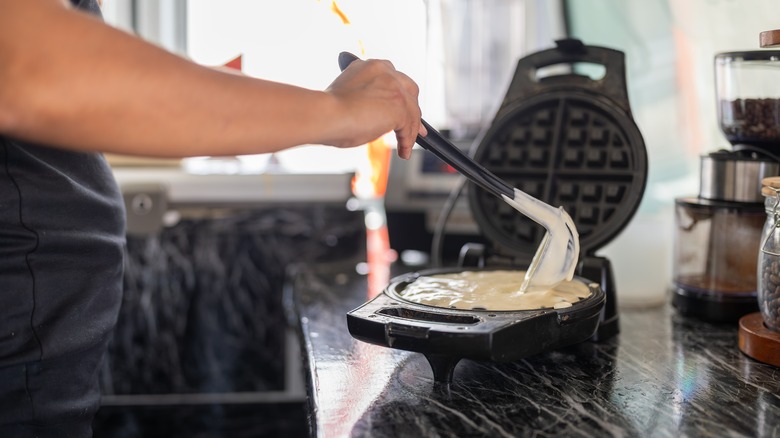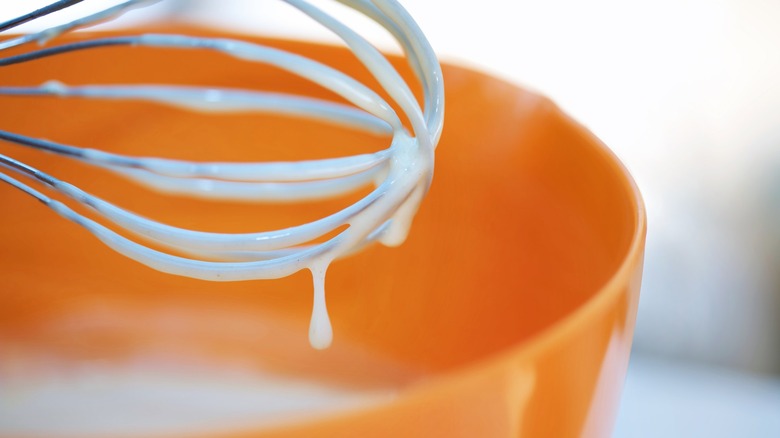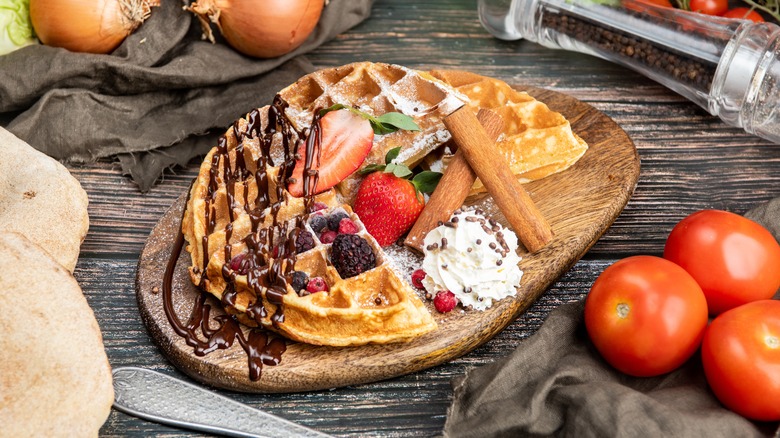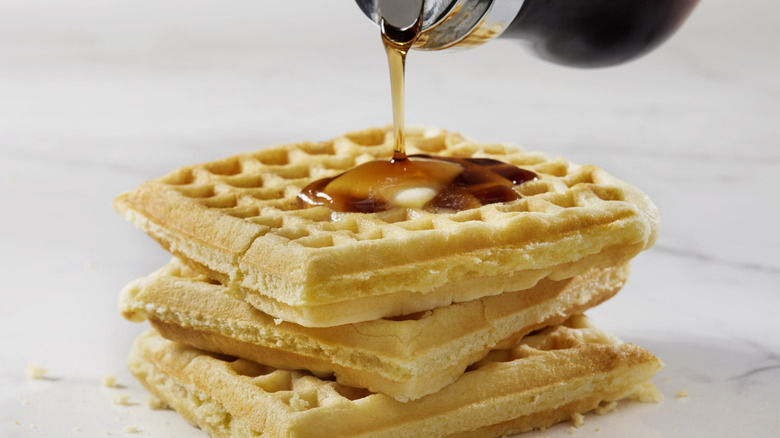Why Waffles Taste Better At Diners Than At Home
If you want the perfect stack of waffles, your closest diner is usually the place to go. Not only do diner waffles invoke a deeply nostalgic feeling at an affordable price, but they taste just as good every single time, with that perfect balance of sweetness and butteriness, and a pillowy interior contained in a crispy shell. So why is it that when you try to make waffles at home, they fall flat? That's because diners have perfected the art of making them over the years, helping them avoid all of those classic mistakes we make when whipping up waffles in our own kitchens.
Many of the main diner waffle secrets are about not what's in these breakfast treats — although there are some sneaky additions that some diner chefs make — but how they're made. Diners will commonly cook their waffles in commercial-grade makers, using heat that's way above the capacity of a standard stove. Additionally, their waffle mixes often come from specific sources. Plus, diners have a few tricks up their sleeves when greasing their waffle irons. Ready to make the best stack of your life? Let's go.
Diners use half-and-half instead of milk
A lot of waffle recipes call for milk, which gives them a creamy, light flavor and gently amps up their sweetness. Diner chefs, however, reach for something a little more exciting when making their waffles. Many of these cooks will use half-and-half into their waffle batter instead of milk, giving their mixture a massive boost of richness and smoothness, while raising the fat content significantly.
The secret to half-and-half's taste lies in this fat content: While most varieties of whole milk are roughly 3% fat, half-and-half (which is a 50-50 mixture of milk and cream) has anywhere between 11 to 18% fat. The exact amount is dependent on each brand's preferred balance of ingredients and base ingredients. These dairy fats don't just give the waffles added richness, either. They also amp up any additional flavors added into the batter, making ingredients like vanilla extract or cocoa powder pop and activate more intensely. If you don't have any half-and-half at home or can't find any at the store, the good news is you can create your own easily. Just mix equal parts cream and whole milk. Then, you can use the combination in place of milk in your recipe for diner-level waffles.
Some diner waffles have vanilla in them
It's amazing how easy it is to make waffles without adding vanilla. However, that's not something that would happen in a diner. Vanilla extract is an absolutely essential ingredient in waffle recipes at diner chains like Waffle House. Vanilla adds that quintessential smooth undertone to waffles, and rounds out the other flavors in the batter, without being too insistent. Its versatility also means that it works seamlessly with pretty much any toppings you choose to add, bolstering flavors without dominating them.
If you wish, you can also substitute your dairy ingredients and vanilla extract for sweet cream. Made from a combination of half-and-half, condensed milk, and vanilla extract, sweet cream will give your waffles a slightly more pronounced vanilla boost while also giving them a hit of sugar and fat. Doing this is also a good way to ensure that you don't add too much vanilla, which can give your waffles a slightly metallic flavor and which can be easily done if you're pouring it in freehand. Just whip up your sweet cream and give it a quick taste test before adding it to your dry ingredients.
Pre-made mixes are used
Your dry ingredients will naturally make up a significant proportion of most simple and classic recipes for waffles, so you'll want to get them just right. However, you might be surprised to hear that lots of diners don't bother trying to get them right in the first place — they just buy a premade mix. Okay, so it may not be that surprising — diner kitchens are busy places after all, and they don't have time to measure out flour every time they need to whip up a batch — but what might surprise you is what's in them.
Premade waffle mixes will often have certain ingredients that help boost their flavor and texture. Golden Malted, a mix brand commonly used by diners, contains your standard enriched wheat flour, but also has corn flour, malted barley extract, buttermilk, and the always-curious "artificial flavor" in its formulation. Golden Dipt is another big-selling brand that has many similar ingredients in its nutritional information (although its Belgian Waffle Base Mix is arguably a way better choice for folks with dairy allergies, as it doesn't contain buttermilk). These mixtures also contain salt and sugar, which amp up their flavor even further.
The batter is often mixed in a bain-marie
Some diners go to some pretty wild extremes to mix their waffle batter. One of the more interesting steps that's taken in places like Waffle House is to mix the batter in a bain-marie. This contraption, also known as a double boiler, consists of a bucket or pot inside another container, with the larger vessel containing water that's heated gently from underneath. The heat from the steam slowly warms the interior pot.
Using a bain-marie can help the batter ingredients come up to temperature slowly and consistently, which then reduces any temperature shock that may occur when it goes into the ultra-hot waffle irons. Waffle House isn't shy about how vigorously they mix their batter, either. Employees have revealed that, to mix the large quantities of wet and dry ingredients, they use a power drill with a paint stirrer attached to the end.
It's worth pointing out that if you're using the bain-marie method, it's wise to avoid heating it too vigorously or too much. Waffle batter contains eggs, and the last thing you want is for them to start cooking from the heat. The idea is to ensure that all the ingredients are the same, low temperature.
Egg whites may be whipped separately
Density is one of the main issues that can befall the humble waffle. Make your batter incorrectly, and you can end up with flat, chewy waffles that have none of the signature springiness that diners manage to achieve. So how do they do it? It's all in the egg whites. Diner chefs will commonly separate their egg yolks from the whites, and then whisk the whites vigorously until they develop a frothy, stiff consistency. This can either be done by hand (it only takes a few minutes) or by using an electric whisk.
When you do this, you aerate your egg whites, filling them with tiny air bubbles and making them light and springy. All of these air bubbles then end up in your batter, and when it's heated by the hot irons these bubbles seal in place, giving your waffles a delightfully tender quality. To keep them intact, it's important not to whisk your egg whites into the other batter ingredients too thoroughly. Just gently fold them in shortly before you're ready to cook them, trying as hard as possible not to pop them or flatten the batter.
Diners use high heat
You can whip up the perfect waffle batter, but unless you've got some seriously high heat, you won't get a good result with it. One thing that separates diner waffles from the kind you make at home is the screamingly high temperature that their commercial makers can reach. This heat helps to develop a super-crisp crust on the outside, while keeping the insides pillowy and moist.
One of the reasons diners can get such high heat is not just because they have more powerful equipment, but because their makers are often hot from previous orders. This means that they're already primed and ready to go, and take less time to complete each waffle. You may not be able to reach quite the same temperatures at home, but a good trick is to give your waffle maker a good few minutes to come up to temperature before cooking your first batch. Alternatively, if you have a gas stove, go for a good old-fashioned stovetop iron which you can heat from underneath. These are slightly messier and can be harder to handle, but they can get to a pretty serious heat.
Cornstarch is sometimes added to the batter
It's probably no surprise that diners have a few secret waffle ingredients up their sleeves. Some of them, though, really aren't that hard to find. One classic trick that diners use when whipping up waffle batter is putting in a combination of flour and cornstarch instead of just flour. Cornstarch makes all the difference. It gives your waffles a crispier exterior while ensuring that they remain airy and tender within.
Cornstarch's secret ability to do this lies in its gluten-free nature. Unlike flour, cornstarch has no gluten at all. It actually limits gluten development. This gluten is what makes waffles dense and chewy, and — while you certainly need a good amount for them to have a delectable bite and a thick batter — the cornstarch cuts through the gluten and stops it from dominating. Importantly, the majority of your batter should still be composed of flour. You should aim to use about a ¼ cup of cornstarch for every 1.5 cups of flour, although some recipes will use slightly less cornstarch. Play around with the ratio to find your perfect balance.
Diners grease their waffle irons with a special oil
Good chefs don't just rely on basic ingredients. Instead, they're aware that there are loads of opportunities to add flavor to a dish during its cooking process. When making waffles, one of the key moments this can be done is in the waffle iron. In diners, chefs will frequently use a butter-flavored oil to grease their irons before they ladle in their batter. This infuses the waffles with a deliciously smooth, buttery flavor, while ensuring that the batter doesn't catch on the hot metal as it sizzles away.
Why don't diner chefs just use butter? Because it burns. Butter is full of milk solids, which is what gives it its creamy flavor. These milk solids are highly prone to burning, and once butter goes above 350 degrees Fahrenheit, it will char and blacken, leaving behind an unpleasant smoky smell and flavor. Although clarified butter can get to a higher temperature, it can be expensive to buy in bulk, and diners are more likely to rely on vegetable oil-based versions that are mixed with butter flavoring.
Malted milk is included in many diner waffle recipes
Anyone who's tried diner waffles knows that there's a certain flavor dimension to them that just can't be replicated at home. Well, get your hands on some malted milk, and you might just be able to. Many diners add malted milk powder to their waffle batters, giving them a nutty, somewhat caramelized flavor in every bite. This malted milk powder (which also amps up cookies) is made from a combination of malt powder, milk solids, and salt. The milk solids add a creamy element, while the malt powder gives that toasted, almost vegetal flavor. The salt, meanwhile, ties everything together and balances the flavors out with a slightly savory edge.
All of these flavor notes work stunningly well in waffles, and serve to deepen their overall taste. This isn't one of those ingredients that can only be found in a food wholesaler, either. Containers of malted milk powder can be bought at Walmart and other major supermarkets for a couple of bucks each. Bear in mind that these powders can be pretty sweet, so if you're adding them to your batter, adjust the amount of sugar you add accordingly.
Some diners add buttermilk
How do diners get so much flavor out of humble waffles? They don't just rely on their base flavor notes of sweetness and creaminess; they also add contrasting elements that provide balance. Many diners will use buttermilk in their waffles, instead of mere milk. This buttermilk adds a note of sourness to the waffles that stops them from being too sweet and cloying, and adds a surprising amount of depth.
Buttermilk does more than just add sour notes, though. Its acidity also makes it gently react with any baking soda added to the batter, which can give it extra lift and lightness. If you don't have any buttermilk but still want this reactive quality and slight sourness, try combining a cup of milk with a tablespoon of lemon juice or white vinegar. You can also use apple cider vinegar –which can give a slightly floral note — but we'd recommend steering clear of any darker vinegars which might give your waffles a strangely developed note. You can also try mixing some milk with plain yogurt to get that tangy taste.
Commercial waffle makers are used
It's probably no surprise that diners aren't using countertop waffle makers to whip up multiple batches, but it's worth noting that the waffle maker you use can have a significant effect on your results. Commercial waffle makers give diner chefs a significantly higher degree of control over their temperatures, allowing them to get to a super-high heat and including alert lights that tell the user when the machine is hot enough. Different lights will often tell the chef when their waffles are done, to avoid them becoming overcooked or burnt.
Commercial waffle makers can also come with all kinds of additional features and accessories that help the user clean them — and so make more consistent waffles each time. Many commercial models will have drip trays that stop excess batter from spilling over the countertop (or risk spilling into the machine itself). While these machines can seem pretty daunting, it's worth noting that the average consumer is totally at liberty to buy and use them. They may be more expensive and take up more counter space, but if you're a waffle lover, it could be an investment worth making.
Diners make the batter in advance
You didn't really think that diners were whipping up batter every single time a waffle order came in, did you? Diners are actually way more likely to make their waffle batters pretty far in advance — and doing this does more than just save time. Many chefs will make their batters over a day before they actually need them. Then, they put them in the fridge to rest. This resting period gives the starch molecules in your flour more time to soak up the liquids in the mixture. As a result, your batter is silkier, resulting in a silkier waffle.
Giving your batter time to rest also relaxes the gluten strands that can form when you mix it. These gluten strands can contribute to your waffles being tougher and more chewy, so giving them time to relax results in a more tender bite. Bear in mind that the longer you leave your batter for, the more it will lose any aeration developed during the mixing process. This might be desirable if you like your waffles chewier, but if you're making batter by folding your egg whites into it, you may want to make it fresh.
More toppings are offered
Why do you get waffles at a diner? Is it honestly for the waffles? Well, yes, they are delicious — but let's be real, a large part of ordering this dish is selecting the toppings that'll go on it. The toppings that diners offer are generally more diverse, exciting, and creative than the ones you can get at home. Diners have the capacity to do things with toppings that you just won't have the time to do at home, whipping up stewed fruits and jams, succulent fried chicken, or sizzling steak in their kitchens. Sure, you can make these yourself, but do you really want to?
Diners are also usually rather generous with their toppings, loading your waffles up with an abundance of extra foods that gives them an indulgent feel. Other diners can get pretty fancy, amping up even the simplest of toppings and making delicious compound butters that melt and release complex flavor onto their waffles. When it comes to the magic of compound butter, though, that's one hack you can do yourself. Just whip your favorite ingredients — maple syrup, mashed berries, or chunks of fudge — into some room-temperature butter, form it into a log, and slice off pats to place on your warm waffles.
Diners use specific syrups
You know that syrup you get on diner waffles — you know, the kind that's so good you could drink it? Well, diners are likely not getting it in any old store. Most diners use Blackburn-Made syrup, a specific kind renowned for its intense, caramelized sweetness and golden-brown color. Blackburn-Made is also the manufacturer of Waffle House's syrup, so you know that if you purchase this product, you're in good company.
So why is Blackburn-Made syrup so good? Because it's pretty much pure sugar. Its Old Fashioned Cane Syrup is made from a combination of corn syrup, high fructose corn syrup, cane syrup, and caramel coloring — with water and a few additives thrown in for good measure. As you might expect, this collection of ingredients doesn't exactly make it the healthiest topping in the world (we don't love that it has high fructose corn syrup in it, either), but if you want that authentic taste, you'll be hard-pressed to find a better option.
